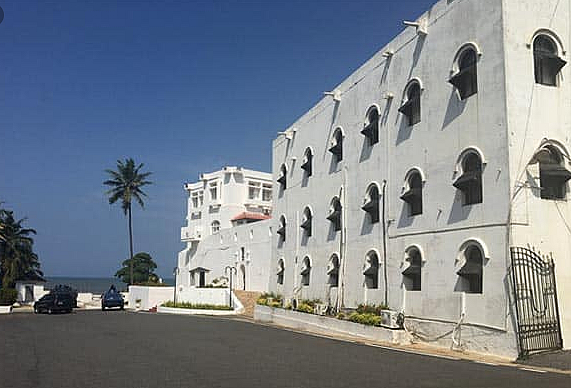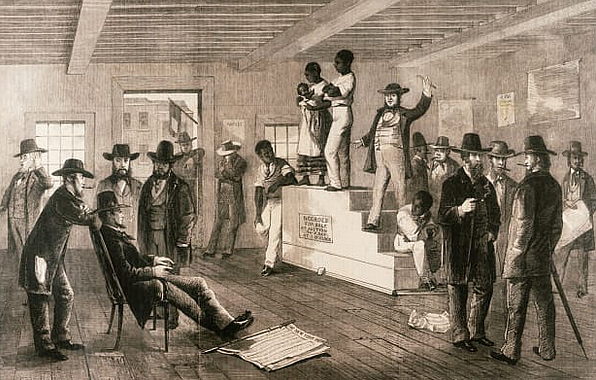Ghanaians have done so well to have preserved their relics of slavery from 1790 to date. It was a sober period for this reporter to see the rooms, sor
Ghanaians have done so well to have preserved their relics of slavery from 1790 to date. It was a sober period for this reporter to see the rooms, sorry, the dungeons where our African ancestors were kept before being transported to the so-called New World to till the sugarcane plantations of the white men.
OSU CASTLE
 According to the Ghana Tourism Authority website, Christiansborg Castle (Osu Castle), also known as Fort Christiansborg or simply the Castle, is a 17th-century castle located on the shores of the vibrant township of Osu, in Ghana’s capital Accra, on the coast of the Atlantic Ocean‘s Gulf of Guinea.
According to the Ghana Tourism Authority website, Christiansborg Castle (Osu Castle), also known as Fort Christiansborg or simply the Castle, is a 17th-century castle located on the shores of the vibrant township of Osu, in Ghana’s capital Accra, on the coast of the Atlantic Ocean‘s Gulf of Guinea.
The first substantial fort was built by the Danes and has changed hands between Denmark, Norway, Portugal, the Akwamu, Britain, and finally post-Independence Ghana, and was rebuilt numerous times.
Christiansborg Castle is also unique among the castles and forts as for most of the castle’s history, it has been the seat of government in Ghana with some interruptions until the seat of government was moved to the Jubilee House.
The castle which is listed by UNESCO as a World Heritage site and some areas around have since 2014 been undergoing archaeological investigations.
In 2017, the castle was converted into a Presidential Museum as part of Ghana’s 60th-anniversary legacy project. It is to be a state of the art museum which would house presidential artefacts, presidential papers, waxworks of our presidents and also on display are personal possessions of past leaders like books, artworks and items of clothing to allow us to honour appropriately their memories
INHUMANITY
Side by side the dungeons are posh facilities where the criminal white slave traders enjoy themselves with their girlfriends and wives, including black females caught as slaves whom they rape at will.
You can see their offices, posh tables and seats, the room and even the beddings used by the Queen of England when she visited Ghana during the colonial days.
 Curiously enough, there is a Church in the castle where the slave traders worship.
Curiously enough, there is a Church in the castle where the slave traders worship.
It stultifies the imagination that while the patrons of the trade worship God on Sundays, a ship of stark inhumanity was before them in the high sea, waiting to transport men and women, who were forcefully separated from their families to a foreign land where they perished for over 400 years!
The Slave trade was the most inhuman form of trade that ever took place on the planet Earth.
The first Europeans to reach the West Coast were the Portuguese. They found a surplus population that could be bought or exchanged with beads, mirrors, and bottles of liquor.
It was not long that the news filtered to those who need men to work in their plantations. Soon, a flotilla of ships began to arrive at the shores of the West Coast.
With the able assistance of the local kings, men and women were captured, chained and led for hundreds of kilometres to the coastal market like Badagry in Nigeria, Salaga and Pikworo slave markets in Ghana where they were sold to the Europeans.
Pictures: Media Associates International (Littworld) Conference, Accra Ghana
CROSS OVER NIGHT: How Churches waste opportunities — By Dr. Bola Adewara .
These unfortunate men, women, and children were led to the coast where they were held in the dungeons of the castles and subsequently carted like fish in slave ships to the plantations in distant lands.
About 10 million people were taken as slaves in the transatlantic slave trade, at rates of up to 100,000 persons per year.
The remnants of the slave trade in Ghana are still visible today in dozens of forts and castles built by Europeans between 1482 and 1786. In the areas that now became Ghana, around 30,000 slaves a year passed through Elmina’s Door of No Return.
The trade went on till 1814 when the Dutch slave trade was abolished, seven years after the British.
THE SLAVE CASTLES
There are about forty slave castles or large commercial forts, built on the Gold Coast of West Africa (now Ghana) by European traders.
There is the Cape Coast Castle, St. George’s d’Elmina Castle and Christiansborg Castle at Osu, Accra.
There are also 15 Forts which include Good Hope at Senya Beraku, Patience at Apam, Amsterdam at Abandzi, St. Jago at Elmina and so many more.
BETWEEN POINT OF NO RETURN AND DOOR OF NO RETURN
In the long chain of movement from the hinterlands to the coast were points where slaves were irredeemably doomed to be transported abroad.
In Badagry, it was called Point of No Return. In Osu Castle, Accra, it was called Door of No Return. In Dakar, Senegal, it was the Goree Island, 3 km off the coast of the city of Dakar, Senegal.
Any slave who got to these points was as good as being in the slave ship, to either be doomed in the sea or arrive to be doomed in the plantation.
SLAVERY IN AMERICA
 The first point of slavery exportation from West Africa was to Portugal.
The first point of slavery exportation from West Africa was to Portugal.
It spread to America in 1619 when the privateer The White Lion brought 20 African slaves ashore in the British colony of Jamestown, Virginia.
America did not host many slaves compared to Brazil and the Caribbean.
Slaves brought to what is now the United States represented about 3.6 per cent of the total number of Africans transported to the New World, or around 388,000 people.
About 1.2 million were taken to Jamaica and 4.8 million to Brazil. Of the about 12 million slaves trafficked between the 16th and 19th centuries, it was surmised that about 1.5 million died on board ships and became fish foods, and about 10.5 million arrived Americas in agonies.
GHANA MUST HAVE EXPORTED THE LARGEST NUMBER OF SLAVES
The number of castles and forts built around the Gold Coast, (now Ghana) is indicative of the fact that the modern-day Gold Coast must have contributed much more than any other area on the West Coast to the slave market.
It is not surprising that many African Americans returned to Ghana and till now, visit the slave relics in a spiritual attachment to the points their grannies were stolen by inhuman white centuries ago.
END OF SLAVERY
Slavery came to an end through a combination of forces. December 1865 is popularly agreed as the final date.
It all began in America through the Union measures such as the Confiscation Acts and Emancipation Proclamation in 1863, the American civil war when Abraham Lincoln ratified the emancipation proclamation.
The ratification of the Thirteenth Amendment in December 1865 formally ended it throughout the United States, which by the time had become the biggest slave transit point in the world.
COMMENTS